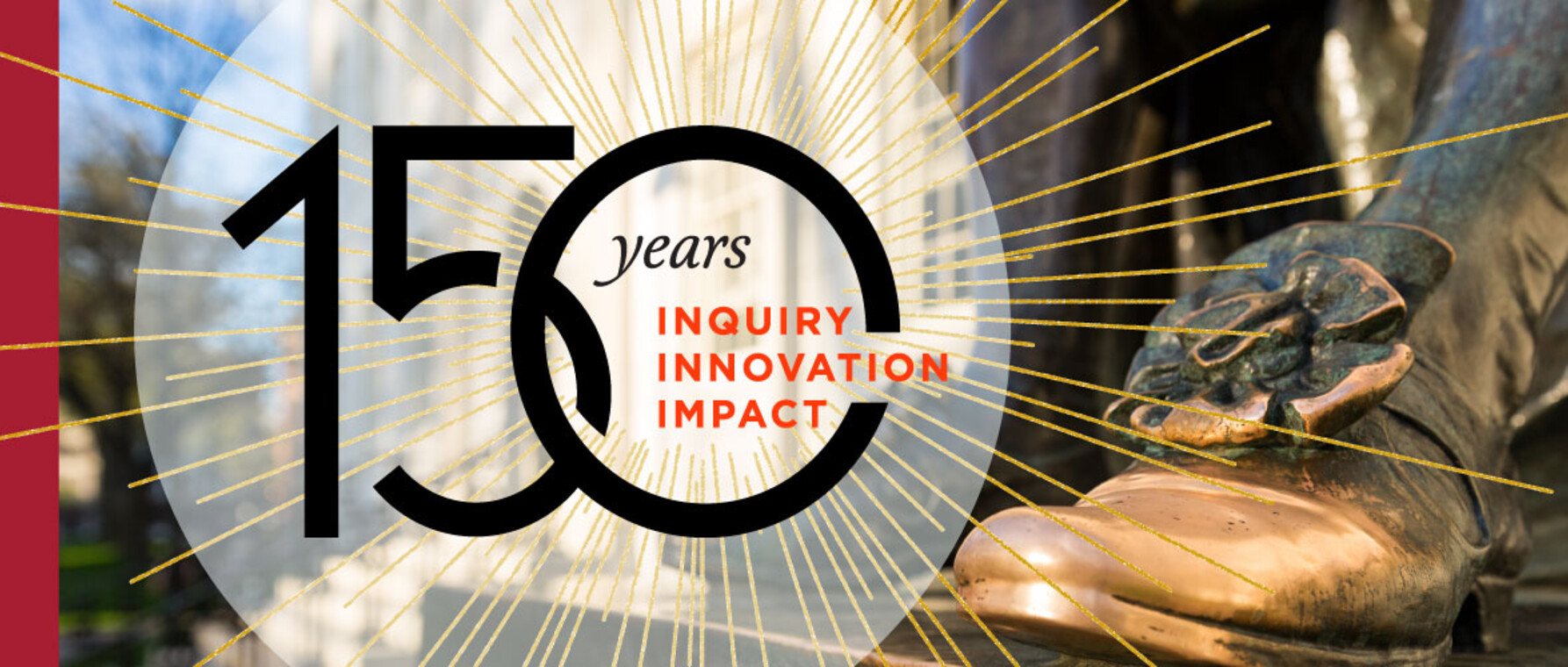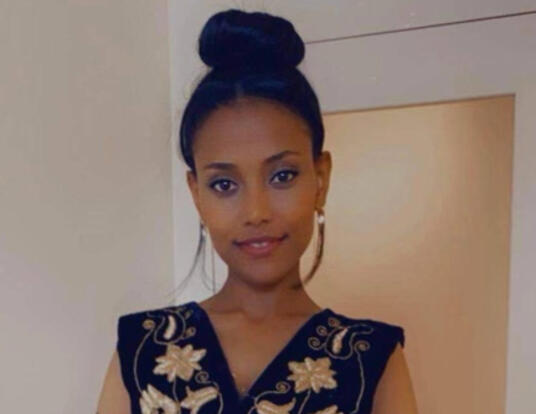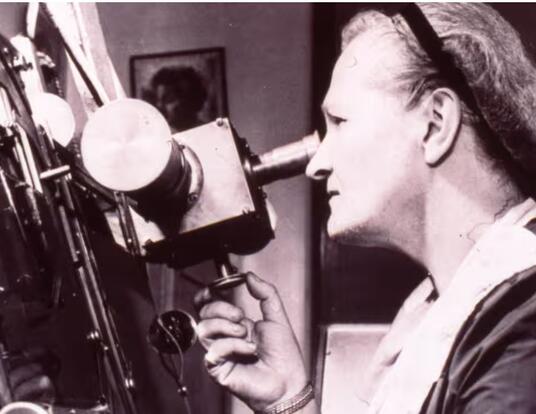Harvard Griffin GSAS History
150 years of expansion, excellence, and influence at Harvard Griffin GSAS and the challenge—and opportunity—of inclusion

"This University recognizes no real antagonism between literature and science, and consents to no such narrow alternatives as mathematics or classics, science or metaphysics. We would have them all, and at their best."
At his inauguration in 1869, Harvard’s new president Charles William Eliot provided a glimpse of his vision for the University: it would be a place where knowledge was advanced through excellence in scholarship and diversity of study.
Though his words were ostensibly directed toward the College, they hinted also at his hopes for advanced study and research at Harvard. He meant for the University to offer graduate programs in the arts and sciences that would equal or surpass that of the grand old institutions of Europe.
Over a century and a half later, the Harvard Kenneth C. Griffin Graduate School of Arts and Sciences welcomes nearly 5,000 students who study in 57 different fields, exceeding Eliot’s wildest imaginings. The School’s story is one of growth and expansion in enrollment, programs, and intellectual and scholarly influence. It is also too often a story of the exclusion of students of color, women, and LGBTQ+ folk. In its 150th anniversary year, both legacies shape what the School is today—and what it strives to become.
This University recognizes no real antagonism between literature and science, and consents to no such narrow alternatives as mathematics or classics, science or metaphysics. We would have them all, and at their best.
–Charles William Eliot
Origins and Growth
By the time of the Civil War in 1861, it was clear that the United States was moving from an agrarian to an industrial society. There was a need for more complex and technical education—and for credentialing that signaled an individual possessed specialized or expert knowledge. In response, the US Congress passed the Morrill Land Grant College Act of 1862, which enabled states to use the proceeds of federally granted lands—many of which had been wrested violently from indigenous peoples—to establish colleges.
As the new institutions proliferated, Harvard’s Eliot was determined to make the University something more than a finishing school for New England’s elite. Although by 1872, the Medical, Divinity, and Law schools had all been around for half a century, Eliot wanted to modernize the study of the natural and social sciences and make Harvard a place where brilliant students from diverse geographies could convene and advance knowledge.
At the time of Eliot’s inauguration, Yale University had offered the PhD for eight years. Schools like Johns Hopkins and the University of Chicago had been founded along the lines of German research universities, considered the best in the western world and the destination for the most talented American scholars until well after the First World War. With the establishment of the Graduate Department in 1872, however, students could now obtain master of arts, doctor of philosophy, and doctor of science degrees from Harvard. The following year, William Byerly became the first to receive a PhD—in mathematics—from the University.
The new unit expanded steadily. In 1875, the first courses primarily for graduate students appeared in the Harvard catalog. In the 1877–1878 academic year, graduate students were first invited to arrange for “special instruction, in the pursuit of higher studies” from Harvard faculty. The PhD program went from three areas of study (mathematics, history, and philosophy) at its inception to seven only two years later, and to 14 by 1888. The growth in fields of study was paralleled by enrollment, which doubled in the School’s first five years, tripled over the next 15 years, and doubled again in the following decade and a half.
With the expansion of graduate education across the University, the Graduate Department sought to distinguish itself from other programs at Harvard. Thus, in 1890, it became the Graduate School of Harvard University, then, finally in 1905, the Graduate School of Arts and Sciences.
Expansion also demanded larger and better facilities for the School and its students. Although historically—as today—most Harvard Griffin GSAS students lived off campus, the School added its first residence hall, Conant Hall, in 1906, joined soon after by a portion of neighboring Perkins Hall.
Within a generation or two, the School’s graduates were distinguishing themselves in the global community of scholars. In 1914, Theodore William Richards became not only the first Harvard Griffin GSAS graduate but also the first member of the Harvard University faculty to receive the Nobel Prize (for chemistry in Richards’s case). He would not be the last.
Still, on the eve of World War I, most experts would not have included Harvard—or any US university—among the top research institutions in the world. The years between the wars dramatically changed the academic landscape. Rising antisemitism, particularly in Germany, drove many of the world’s greatest scientists to American institutions, including Harvard. They included Niels Bohr, Albert Einstein, James Franck, Eugene Wigner, and many others. By 1977, Jewish scientists accounted for more than a quarter of all US Nobel Prize winners.
World War II had wide-ranging consequences for Harvard Griffin GSAS. Enrollment, which peaked at over 1,100 in 1939, dropped below 400 in 1944, a year before the war’s end. In the peace that followed, the GI Bill helped “democratize the PhD,” according to Harvard Griffin GSAS Dean Payson S. Wild, funding the graduate studies of veterans and driving the School’s enrollment to nearly 2,000. Areas of study grew too. By the mid-20th century, the PhD program encompassed 53 fields, from anthropology and biochemistry to medical sciences, physics, and philology.
Despite its expansion, Harvard Griffin GSAS offered its students no on-campus space that they could call their own outside of a large common room in Conant Hall, located on the outskirts of Harvard’s Cambridge campus. In the School’s early years, the Union—now the Mahindra Humanities Center—served as an all-student center. After the College established the House system for upper-class students in the 1930s, however, it claimed the Union exclusively for first-year undergraduates. In the ensuing decades, Harkness Commons in the North Yard was constructed as a joint center for students of both Harvard Law School (HLS) and Harvard Griffin GSAS. The space was too out of the way for most master’s and PhD students, though, and HLS enrollees soon came to dominate it. In the 1970s, Harvard Griffin GSAS students were allowed to become “social members” of Dudley House—Harvard’s campus center for non-resident undergraduates—but it wasn’t until 1983 that they got a room of their own there, the Graduate Student Lounge.
In 1969, a faculty committee headed by Professor Robert Lee Wolff confronted challenges that would be familiar to Harvard Griffin GSAS leaders today: more students, decreasing public and private support for graduate studies as support from the GI Bill ran out, and a decline in academic job opportunities for alumni. Though the report recommended a 20 percent reduction in enrollment, it also served as a catalyst for the shift to a need-based financial aid policy, with the idea that all Harvard Griffin GSAS students should have the resources to complete their education. Funding for graduate study expanded—often significantly—through the 1990s and 2000s.
In the decades after the report of the Wolff Committee, the School’s growth continued with enrollment pushing beyond 4,000 students. In response, Harvard Griffin GSAS doubled its residential living spaces, adding Child and Richards halls to Conant and Perkins. The School was reorganized in the 1980s to streamline operations and increase responsiveness to students and faculty. After years of advocacy by Harvard Griffin GSAS students and administrators, Dudley House in the 1990s formally broadened its mission to include serving Harvard Griffin GSAS students as well as non-resident undergraduates. The 2000s saw new housing, the creation of several new interdisciplinary and interfaculty PhD programs, the formation of the Harvard Integrated Life Sciences Program, and a summer language program for incoming international students. In 2019, the School’s students finally got a home of their own when Harvard College assumed oversight for the non-resident undergraduate community and Lehman Hall in Harvard Yard—formerly the site of Dudley House—became the Student Center at Harvard Griffin GSAS.
Years of Exclusion
For much of the School’s history, the passion for diversity exemplified by the different disciplines studied at Harvard Griffin GSAS was not reflected in its student body, which consisted only of white men until late in the 19th century when W.E.B. Du Bois became the first Black American to receive a PhD from Harvard (1895). Like the students of color who came after him well into the 20th century, Du Bois found little support from his classmates or the administration, experienced financial pressures that were uncommon among his fellow students, and often felt isolated. “I went to Harvard as a Negro…recognizing myself as a member of a segregated caste whose situation I accepted,” he wrote years later.
During Eliot’s presidency, Harvard began admitting small numbers of Black students, hired its first Black faculty member, and bestowed its first honorary degree on a Black man, Booker T. Washington. But Eliot, essentially the founder of the Harvard Griffin GSAS, also promoted eugenics, race science, and racial segregation, as did prominent members of the faculty who taught and advised PhD students.
For much of the School’s history, the passion for diversity exemplified by the different disciplines studied at Harvard Griffin GSAS was not reflected in its student body, which consisted only of white men until late in the 19th century when W.E.B. Du Bois became the first Black American to receive a PhD from Harvard (1895).
Though small in number for much of its history, Black Harvard Griffin GSAS graduates had an outsized impact on society, culture, and world affairs. In addition to Du Bois—a co-founder of the National Association for the Advancement of Colored People, an accomplished sociologist, and a towering figure in 20th-century thinking on race—the School’s Black alumni included Ralph Bunche, architect of the United Nations and the first person of color to receive the Nobel Peace Prize; Carter Woodson, the pioneering historian of the African diaspora; Alain Locke, Bunche’s mentor at Howard University and the leader of the Harlem Renaissance; and John Hope Franklin, a groundbreaking scholar of African American history. Despite the achievements of these alumni, however, Harvard Griffin GSAS would not admit more than a handful of students of color each year until the 1970s.
Women could not enroll at Harvard Griffin GSAS until 1962; however, they did pursue graduate studies through the Harvard Annex, later known as Radcliffe College, which granted its first master of arts “certificate” in 1890. In 1894, Radcliffe College became a degree-granting institution, awarding its first PhD in 1902. The School produced some of the University’s first female advanced degree recipients of color, including Eva B. Dykes, a scholar of English literature and the first Black woman in the United States to complete the requirements for a PhD (1921). Enrollment grew, and by 1930, Radcliffe had become the largest graduate school among women’s colleges.
In 1934, Harvard established the Radcliffe Graduate School. Some of its distinguished PhDs include the late philosopher Susanne Knauth Langer; astronomer Cecilia Payne-Gaposchkin, the second woman to receive tenure in Harvard’s Faculty of Arts and Sciences; geophysicist Margaret Kivelson; and Jean Berko Gleason, a psycholinguist whose research transformed scholars’ understanding of how children acquire language.
Discrimination against LGBTQ+ folk may have been less visible, but it was no less severe. In 1920, after consulting with University President Abbott Lawrence Lowell, Harvard Griffin GSAS alumnus and Harvard College Dean Chester N. Greenough organized and led an investigation into allegations of homosexual behavior in Perkins Hall, which housed both College and Harvard Griffin GSAS students. (Today, the residents of Perkins Hall are exclusively graduate students.) When the investigation was finished, Greenough instructed eight undergraduates found “guilty” by him and his fellow administrators to leave not only Harvard but also the City of Cambridge. A recent graduate was also banned from campus. An assistant professor lost his job. While the students and alumnus were affiliated with the College rather than Harvard Griffin GSAS, the “Secret Court of 1920” underscored the dangers of being queer on campus.
Excellence and Inclusion
As the School grew, so did the achievements of its graduates, who include some of the great scientists, thinkers, and leaders of the last 150 years. To date, 56 Harvard Griffin GSAS alumni have joined Theodore William Richards as Nobel Laureates: physicists like Adam Riess and Brian Schmidt, who charted the expansion of the universe; scientists like Craig Mello, who advanced knowledge of the building blocks of life, and Jennifer Doudna, pioneer of the gene-editing technology CRISPR; and economists like Michael Kremer and Abhijit Banerjee, who developed new approaches to alleviating global poverty. Alumni winners of the Fields Medal for outstanding achievement in mathematics included Maryam Mirzakhani, the first woman to receive the award. In the arts and humanities, composers John Coolidge Adams and Du Yun, poets Maxine Kumin and Lloyd Schwartz, and historians Caroline Elkins and Bernard Bailyn all were among the School’s many graduate winners of the Pulitzer Prize.
Throughout its history, Harvard Griffin GSAS has helped set the standard for graduate study and shaped both Harvard and the academy. So have its graduates. Since the establishment of the Graduate Department in 1872, five of the eight presidents appointed to lead the University have been Harvard Griffin GSAS alumni. In addition to being leaders on the faculties of some of the world’s top colleges and universities, Harvard Griffin GSAS graduates have been the presidents of peer institutions including Stanford, Columbia, the University of Chicago, Brown, the University of Pennsylvania, and even Yale.
Perhaps the greatest indicator of the impact that Harvard Griffin GSAS has had in the world is evidenced by the number of alumni who have received the highest civilian honor in the United States—the Presidential Medal of Freedom. Given in recognition of "an especially meritorious contribution to the security or national interests of the United States, world peace, cultural or other significant public or private endeavors," the medal has been bestowed on Harvard PhDs including Ralph Bunche, James Conant, Zbigniew Brzezinski, Hannah Holborn Gray, and John Hope Franklin, among others.
Even as the School built on its legacy of excellence and leadership, it increasingly confronted its legacy of exclusion. In his 1969–70 Dean’s Report to the Dean of the FAS, Harvard Griffin GSAS Dean J.P. Elder noted that the lack of diversity within the student population stemmed not only from a lack of candidates for admission but also from finding eligible prospective applicants and convincing them that this “hitherto abrasively indifferent institution” really did want them to apply. To address the issue, Elder appointed Joseph Strickland as a special assistant to the dean, tasked with visiting colleges throughout the United States. Thanks to Strickland’s efforts, 170 Black undergraduates applied and 42 were ultimately offered admission. In the late 1980s, the School established a minority recruitment program and significantly increased outreach to historically Black colleges and universities, as well as institutions that traditionally served the Latinx community. In the 1990s, it added staff dedicated to this work.
Today, under Dean Emma Dench, Harvard Griffin GSAS is committed to the notion that academic excellence goes hand in hand with inclusion.
In the 2010s, Harvard Graduate Women in Science and Engineering and LGBTQ@GSAS joined the W.E.B. Du Bois Graduate Society as umbrella student groups receiving direct budgetary support from Harvard Griffin GSAS. The greatest development in the School’s inclusion efforts, however, was the establishment of the Office of Diversity and Minority Affairs under the direction of Dr. Sheila Thomas, now Harvard Griffin GSAS’s dean for equity, diversity, inclusion & belonging, interim dean of students, and special projects advisor. Recently renamed the Office of Equity, Diversity, Inclusion, and Belonging (OEDIB), the team of five staff and three student diversity and inclusion fellows works to increase outreach and recruitment to traditionally marginalized groups, to develop programs that help participants gain valuable research experience in preparation for the PhD, and “to create an inclusive environment where all students can thrive and grow academically and personally.”
Today, under Dean Emma Dench, Harvard Griffin GSAS is committed to the notion that academic excellence goes hand in hand with inclusion, with an astonishingly diverse community enrolled at the School in AY 2022-2023. These students are able to enroll at Harvard Griffin GSAS thanks to a greatly expanded financial aid program—one which the School is committed to improving still more in the years to come. Many work in disciplines of which scholars in President Eliot’s day could hardly have conceived: quantum science and engineering, bioinformatics, integrative genomics, and many other fields. But the School still hews to the more hopeful aspects of Eliot’s vision, if in ways that it would challenge him to recognize: whether students of different identities and backgrounds or new areas of knowledge, Harvard Griffin GSAS would have them all—and at their best.
Get the Latest Updates
Join Our Newsletter
Subscribe to Colloquy Podcast
Simplecast





